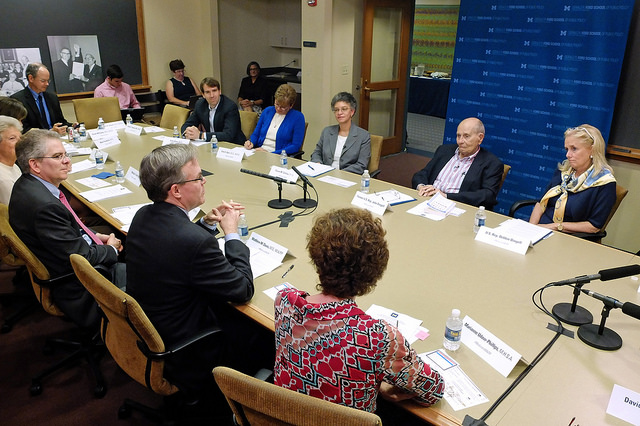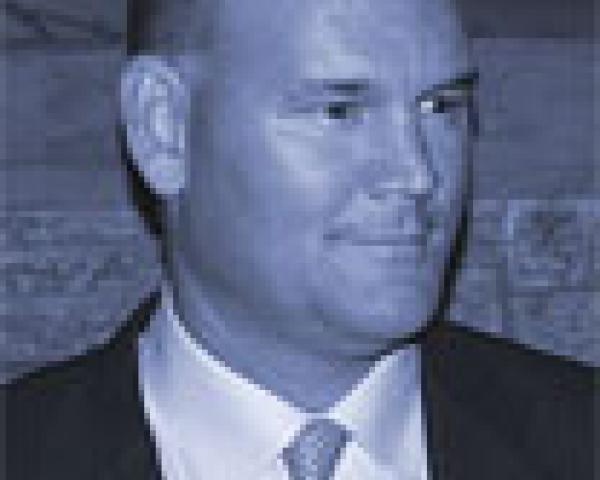Why I’m Skeptical on Apple’s Future
Innovation now follows a clear path, in insurance and elsewhere. Apple is showing the perils of not following that path.

Innovation now follows a clear path, in insurance and elsewhere. Apple is showing the perils of not following that path.

Get Involved
Our authors are what set Insurance Thought Leadership apart.
|
Partner with us
We’d love to talk to you about how we can improve your marketing ROI.
|

Vivek Wadhwa is a fellow at Arthur and Toni Rembe Rock Center for Corporate Governance, Stanford University; director of research at the Center for Entrepreneurship and Research Commercialization at the Pratt School of Engineering, Duke University; and distinguished fellow at Singularity University.
Those who invoke the grand bargain and dismiss alternatives to workers' comp somehow don't disclose their financial incentives.

Get Involved
Our authors are what set Insurance Thought Leadership apart.
|
Partner with us
We’d love to talk to you about how we can improve your marketing ROI.
|

Daryl Davis is a member of the American College of Occupational and Environmental Medicine and is sought after by governmental agencies, insurance carriers, risk managers and others in this field. Davis founded www.WorkersCompensationOptions.com, a company committed to WC and legal alternatives to WC.
5-STAR ratings provide a good overview for nursing home quality, but there are flaws inherent to this system.

Get Involved
Our authors are what set Insurance Thought Leadership apart.
|
Partner with us
We’d love to talk to you about how we can improve your marketing ROI.
|

Brad Granger is the vice president of underwriting for Ultra – a new program providing liability coverage for senior living facilities. He brings more than 20 years of experience in operations and risk management in the long term care industry. He is a licensed nursing home administrator as well as a licensed P & C producer.
There is now a software marketplace where people can invest in bonds backed by insurance risks, improving allocation of capital.

Get Involved
Our authors are what set Insurance Thought Leadership apart.
|
Partner with us
We’d love to talk to you about how we can improve your marketing ROI.
|

Shefi Ben Hutta is the founder of InsuranceEntertainment.com, a refreshing blog offering insurance news and media that Millennials can relate to. Originally from Israel, she entered the U.S. insurance space in 2007 and since then has gained experience in online rating models.
By limiting scope initially, providers can define a business case, derive insights and build momentum to tackle larger challenges.

Get Involved
Our authors are what set Insurance Thought Leadership apart.
|
Partner with us
We’d love to talk to you about how we can improve your marketing ROI.
|

Munzoor Shaikh is a director in West Monroe Partners' healthcare practice, with a primary focus on managed care, health insurance, population health and wellness. Munzoor has more than 15 years of experience in management and technology consulting.
Like Schrodinger's cat, claims about the Oklahoma Option need to be kept in a locked box, far from prying eyes.

Get Involved
Our authors are what set Insurance Thought Leadership apart.
|
Partner with us
We’d love to talk to you about how we can improve your marketing ROI.
|

Bob Wilson is a founding partner, president and CEO of WorkersCompensation.com, based in Sarasota, Fla. He has presented at seminars and conferences on a variety of topics, related to both technology within the workers' compensation industry and bettering the workers' comp system through improved employee/employer relations and claims management techniques.
There are six opportunities that incumbents need to explore to meet customer needs while improving core functions.




 As Figures 2 and 3 show, activity around early-stage InsurTech companies has generated considerable buzz. Moreover, experienced insurance executives have joined start-ups, including Insureon and Lemonade, to help them develop new types of products and services, like small business aggregators and peer-to-peer insurance models. All of this indicates that investors and the industry are eager to get on board with early stage start-ups to meet the six areas of opportunity we illustrate above and describe in detail as follows:
1) Meet changing customer needs with new offerings – Customer now expect personalized insurance solutions. One size simply does not fit all any more. Usage-based models are partially addressing these expectations, but the sharing economy also is challenging existing, more traditional insurance products. New players are able work from a clean slate and leverage a variety of available resources to fill market gaps. For example:
As Figures 2 and 3 show, activity around early-stage InsurTech companies has generated considerable buzz. Moreover, experienced insurance executives have joined start-ups, including Insureon and Lemonade, to help them develop new types of products and services, like small business aggregators and peer-to-peer insurance models. All of this indicates that investors and the industry are eager to get on board with early stage start-ups to meet the six areas of opportunity we illustrate above and describe in detail as follows:
1) Meet changing customer needs with new offerings – Customer now expect personalized insurance solutions. One size simply does not fit all any more. Usage-based models are partially addressing these expectations, but the sharing economy also is challenging existing, more traditional insurance products. New players are able work from a clean slate and leverage a variety of available resources to fill market gaps. For example:
 More specifically, insurers are:
More specifically, insurers are:
Get Involved
Our authors are what set Insurance Thought Leadership apart.
|
Partner with us
We’d love to talk to you about how we can improve your marketing ROI.
|

Anand Rao is a principal in PwC’s advisory practice. He leads the insurance analytics practice, is the innovation lead for the U.S. firm’s analytics group and is the co-lead for the Global Project Blue, Future of Insurance research. Before joining PwC, Rao was with Mitchell Madison Group in London.

Jamie Yoder is president and general manager, North America, for Sapiens.
Previously, he was president of Snapsheet, Before Snapsheet, he led the insurance advisory practice at PwC.
Injured workers are being stripped of their workers' comp settlement funds because they are routinely overpaying for treatment.

Get Involved
Our authors are what set Insurance Thought Leadership apart.
|
Partner with us
We’d love to talk to you about how we can improve your marketing ROI.
|

Porter Leslie is the president of Ametros. He directs the growth of Ametros and works with its many partners and clients.
The Anthem lawsuit against Express Scripts should raise a key question: Is my employer in the same boat as Anthem?

Get Involved
Our authors are what set Insurance Thought Leadership apart.
|
Partner with us
We’d love to talk to you about how we can improve your marketing ROI.
|

Scott Martin is the founder, CEO and chairman of Remedy Analytics, a healthcare data analytics technology company that partners with employers to protect their prescription benefit interests. Martin is a three-time entrepreneur dedicated to making healthcare easily comprehensible and affordable for patients and providers.
Want to strengthen your customer relationships? Go beyond legally required disclosures. Communicate in a clear and forthright way.

 In this paragraph, Amazon notes the program is not intended for use with “life-critical or safety-critical systems,” except if the Centers for Disease Control and Prevention (CDC) declares the presence of a “widespread viral infection transmitted by bites or contact with bodily fluids that cause human corpses to reanimate and seek to consume living human flesh, blood, brain or nerve tissue and is likely to result in the fall of organized civilization.”
Translation: If the zombie apocalypse comes to pass, you can use Lumberyard for whatever the heck you want.
All right, so Amazon is injecting some humor in what are typically long, boring and dense terms of service that, let’s face it, no one ever reads—for any company.
But the fact that the flesh-eating undead can be referenced in a document like this with almost nobody noticing speaks to a larger and more serious issue: Disclosure documents like Amazon's are an awful way to communicate important information to your customer.
Companies bury important details in opaque disclosures they count on no one reading. Examples abound—coverage exclusions for your insurance, service fees for your bank account, cancellation fees for your gym membership, price increases for your cable TV package or conflicts of interest for your financial adviser. Organizations hide behind these disclosure documents and point to them as evidence that anything important is, indeed, revealed to the customer.
But here’s the key these companies are missing: Disclosure is not a proxy for transparency. Indeed, as practiced these days (with pages of unintelligible fine print), disclosure is the antithesis of transparency. So let’s start referring to disclosure documents for what they really are: a tool businesses use to convey information they don’t want anyone to see. Until more companies reject such disingenuous practices (like Southwest Airlines has done with its Transfarency strategy), consumer trust in businesses will continue to erode.
Do you want to strengthen your customer relationships? Go beyond the legally required disclosures and start communicating with people in a clear and forthright way. That sends a signal to your customers that you’re advocating for them and helping them avoid unpleasant surprises, whether that's in the form of excessive fees, conflicts of interest or, even, the zombie-induced fall of organized civilization.
That’s the kind of advocacy from which loyal brand advocates are born.
This article first appeared at Watermark Consulting.
In this paragraph, Amazon notes the program is not intended for use with “life-critical or safety-critical systems,” except if the Centers for Disease Control and Prevention (CDC) declares the presence of a “widespread viral infection transmitted by bites or contact with bodily fluids that cause human corpses to reanimate and seek to consume living human flesh, blood, brain or nerve tissue and is likely to result in the fall of organized civilization.”
Translation: If the zombie apocalypse comes to pass, you can use Lumberyard for whatever the heck you want.
All right, so Amazon is injecting some humor in what are typically long, boring and dense terms of service that, let’s face it, no one ever reads—for any company.
But the fact that the flesh-eating undead can be referenced in a document like this with almost nobody noticing speaks to a larger and more serious issue: Disclosure documents like Amazon's are an awful way to communicate important information to your customer.
Companies bury important details in opaque disclosures they count on no one reading. Examples abound—coverage exclusions for your insurance, service fees for your bank account, cancellation fees for your gym membership, price increases for your cable TV package or conflicts of interest for your financial adviser. Organizations hide behind these disclosure documents and point to them as evidence that anything important is, indeed, revealed to the customer.
But here’s the key these companies are missing: Disclosure is not a proxy for transparency. Indeed, as practiced these days (with pages of unintelligible fine print), disclosure is the antithesis of transparency. So let’s start referring to disclosure documents for what they really are: a tool businesses use to convey information they don’t want anyone to see. Until more companies reject such disingenuous practices (like Southwest Airlines has done with its Transfarency strategy), consumer trust in businesses will continue to erode.
Do you want to strengthen your customer relationships? Go beyond the legally required disclosures and start communicating with people in a clear and forthright way. That sends a signal to your customers that you’re advocating for them and helping them avoid unpleasant surprises, whether that's in the form of excessive fees, conflicts of interest or, even, the zombie-induced fall of organized civilization.
That’s the kind of advocacy from which loyal brand advocates are born.
This article first appeared at Watermark Consulting.
Get Involved
Our authors are what set Insurance Thought Leadership apart.
|
Partner with us
We’d love to talk to you about how we can improve your marketing ROI.
|

Jon Picoult is the founder of Watermark Consulting, a customer experience advisory firm specializing in the financial services industry. Picoult has worked with thousands of executives, helping some of the world's foremost brands capitalize on the power of loyalty -- both in the marketplace and in the workplace.